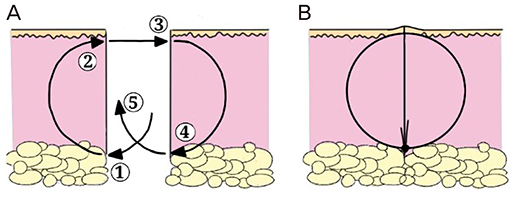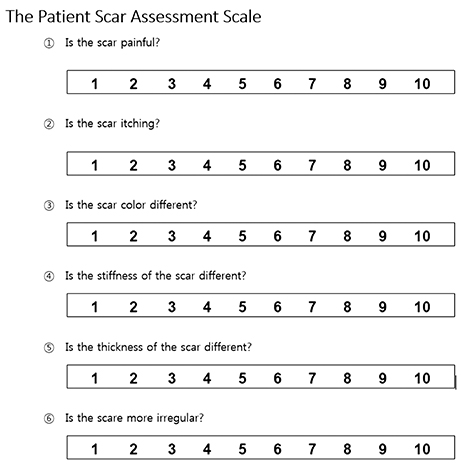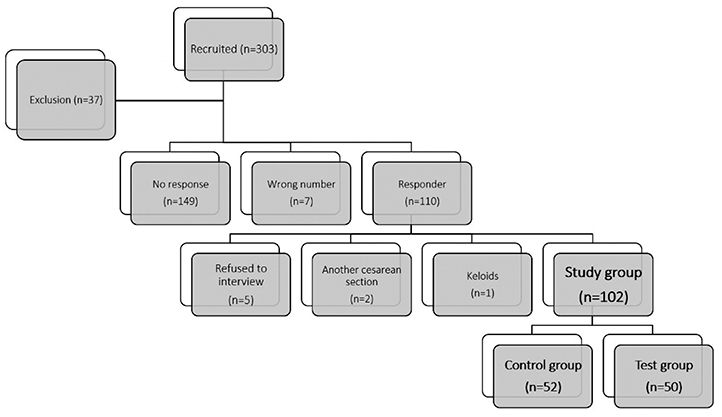Obstet Gynecol Sci.
2018 Jan;61(1):79-87. 10.5468/ogs.2018.61.1.79.
Cosmetic outcomes of cesarean section scar; subcuticular suture versus intradermal buried suture
- Affiliations
-
- 1Department of Obstetrics and Gynecology, Pusan National University Yangsan Hospital, Yangsan, Korea. ldh0707@hanmail.net
- 2Department of Obstetrics and Gynecology, Pusan National University Hospital, Busan, Korea.
- KMID: 2420155
- DOI: http://doi.org/10.5468/ogs.2018.61.1.79
Abstract
OBJECTIVE
The objective of the study was to compare cosmetic outcomes and overall satisfaction rate of cesarean section scar between conventional subcuticular suture and intradermal buried vertical mattress.
METHODS
Patients were enrolled to the study by chart review. A scar assessment was obtained retrospectively through a telephone survey. The patient component of the patient and observer scar assessment scale (POSAS) was utilized along with the overall satisfaction of the patient regarding their cesarean section scar and their willingness to choose the same skin closure technique when anticipating their next cesarean section.
RESULTS
A total of 303 cases of cesarean section was recruited, 102 finished telephone surveys were calculated for the analyses. Subcuticular suture was regarded as control group (n=52) and intradermal buried suture as test group (n=50). The PSAS score of the test group (mean, 21.8) was lower than that of the control group (mean, 28), with a statistical significance (P=0.02). Overall satisfaction rate did not differ between the two groups. Two parameters of the PSAS score and the level of overall satisfaction showed significant correlation (Pearson's r, −0.63; P < 0.01).
CONCLUSION
We suggested the use of intradermal buried vertical mattress as a cosmetically superior skin closure method for application in cesarean sections over subcuticular stitch.
Keyword
MeSH Terms
Figure
Cited by 1 articles
-
Wound complication among different skin closure techniques in the emergency cesarean section: a randomized control trial
Bhimeswar Nayak G, Pradip Kumar Saha, Rashmi Bagga, Bharti Joshi, Minakshi Rohilla, Shalini Gainder, Pooja Sikka
Obstet Gynecol Sci. 2020;63(1):27-34. doi: 10.5468/ogs.2020.63.1.27.
Reference
-
1. Statistics Korea. Korean population trend survey. Daejeon (KR): Statistics Korea;2015.2. Statistics Korea. Monitoring of cesarean section rate in Korea. Daejeon (KR): Statistics Korea;2015.3. Dahlke JD, Mendez-Figueroa H, Rouse DJ, Berghella V, Baxter JK, Chauhan SP. Evidence-based surgery for cesarean delivery: an updated systematic review. Am J Obstet Gynecol. 2013; 209:294–306.
Article4. Hofmeyr GJ, Mathai M, Shah A, Novikova N. Techniques for caesarean section. Cochrane Database Syst Rev. 2008; CD004662.
Article5. Cunningham FG, Leveno KJ, Bloom SL, Hauth JC, Rouse DJ, Spong CY. Williams obstetrics. 23rd ed. New York (NY): McGraw-Hill Medical;2010.6. Basha SL, Rochon ML, Quiñones JN, Coassolo KM, Rust OA, Smulian JC. Randomized controlled trial of wound complication rates of subcuticular suture vs staples for skin closure at cesarean delivery. Am J Obstet Gynecol. 2010; 203:285.e1–285.e8.
Article7. Figueroa D, Jauk VC, Szychowski JM, Garner R, Biggio JR, Andrews WW, et al. Surgical staples compared with subcuticular suture for skin closure after cesarean delivery: a randomized controlled trial. Obstet Gynecol. 2013; 121:33–38.8. Mackeen AD, Berghella V, Larsen ML. Techniques and materials for skin closure in caesarean section. Cochrane Database Syst Rev. 2012; 11:CD003577.
Article9. Tuuli MG, Rampersad RM, Carbone JF, Stamilio D, Macones GA, Odibo AO. Staples compared with subcuticular suture for skin closure after cesarean delivery: a systematic review and meta-analysis. Obstet Gynecol. 2011; 117:682–690.
Article10. Alderdice F, McKenna D, Dornan J. Techniques and materials for skin closure in caesarean section. Cochrane Database Syst Rev. 2003; CD003577.
Article11. Moy RL, Waldman B, Hein DW. A review of sutures and suturing techniques. J Dermatol Surg Oncol. 1992; 18:785–795.
Article12. Kudur MH, Pai SB, Sripathi H, Prabhu S. Sutures and suturing techniques in skin closure. Indian J Dermatol Venereol Leprol. 2009; 75:425–434.
Article13. Hohenleutner U, Egner N, Hohenleutner S, Landthaler M. Intradermal buried vertical mattress suture as sole skin closure: evaluation of 149 cases. Acta Derm Venereol. 2000; 80:344–347.14. Rieger S, Zhao H, Martin P, Abe K, Lisse TS. The role of nuclear hormone receptors in cutaneous wound repair. Cell Biochem Funct. 2015; 33:1–13.
Article15. Yagmur C, Akaishi S, Ogawa R, Guneren E. Mechanical receptor-related mechanisms in scar management: a review and hypothesis. Plast Reconstr Surg. 2010; 126:426–434.
Article16. Rousseau JA, Girard K, Turcot-Lemay L, Thomas N. A randomized study comparing skin closure in cesarean sections: staples vs subcuticular sutures. Am J Obstet Gynecol. 2009; 200:265.e1–265.e4.
Article17. Gaertner I, Burkhardt T, Beinder E. Scar appearance of different skin and subcutaneous tissue closure techniques in caesarean section: a randomized study. Eur J Obstet Gynecol Reprod Biol. 2008; 138:29–33.
Article18. Huppelschoten AG, van Ginderen JC, van den Broek KC, Bouwma AE, Oosterbaan HP. Different ways of subcutaneous tissue and skin closure at cesarean section: a randomized clinical trial on the long-term cosmetic outcome. Acta Obstet Gynecol Scand. 2013; 92:916–924.
Article19. Cromi A, Ghezzi F, Gottardi A, Cherubino M, Uccella S, Valdatta L. Cosmetic outcomes of various skin closure methods following cesarean delivery: a randomized trial. Am J Obstet Gynecol. 2010; 203:36.e1–36.e8.
Article20. Kaartinen I. Assessment of skin scars in clinical practice and scientific studies. Tampere (FI): University of Tampere;2011.21. Draaijers LJ, Tempelman FR, Botman YA, Kreis RW, Middelkoop E, van Zuijlen PP. Colour evaluation in scars: tristimulus colorimeter, narrow-band simple reflectance meter or subjective evaluation? Burns. 2004; 30:103–107.
Article22. Durani P, McGrouther DA, Ferguson MW. The Patient Scar Assessment Questionnaire: a reliable and valid patient-reported outcomes measure for linear scars. Plast Reconstr Surg. 2009; 123:1481–1489.
Article23. Mercandetti M, Cohen AJ. Wound healing: healing and repair. [place unknown]: Emedicine.com;2005.24. Brown BC, Moss TP, McGrouther DA, Bayat A. Skin scar preconceptions must be challenged: importance of self-perception in skin scarring. J Plast Reconstr Aesthet Surg. 2010; 63:1022–1029.
Article25. Brown BC, McKenna SP, Siddhi K, McGrouther DA, Bayat A. The hidden cost of skin scars: quality of life after skin scarring. J Plast Reconstr Aesthet Surg. 2008; 61:1049–1058.
Article26. Guo S, Dipietro LA. Factors affecting wound healing. J Dent Res. 2010; 89:219–229.
Article27. Hasdemir PS, Guvenal T, Ozcakir HT, Koyuncu FM, Dinc Horasan G, Erkan M, et al. Comparison of subcuticular suture materials in cesarean skin closure. Surg Res Pract. 2015; 2015:141203.
Article
- Full Text Links
- Actions
-
Cited
- CITED
-
- Close
- Share
- Similar articles
-
- Secure and Convenient Three-point and Multi-point Suture Technique
- Treatment of Benign Tumors by Excision Using Purse-String Suture
- Double Eyelid Operation using Subconjunctival Buried Suture Method
- Clinical Comparison of the Scar Revision According to Two Different Intradermal and Skin Suture Technique
- Double Eyelid Operation in Middle-aged Women by Buried Suture Method





